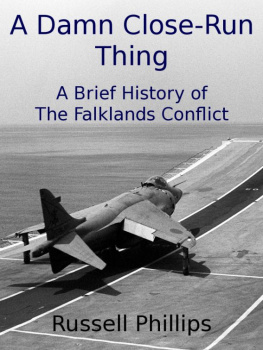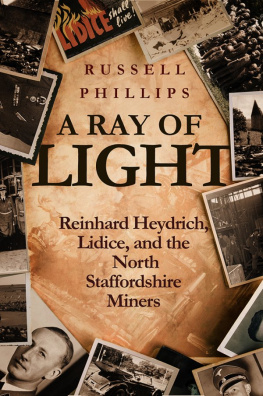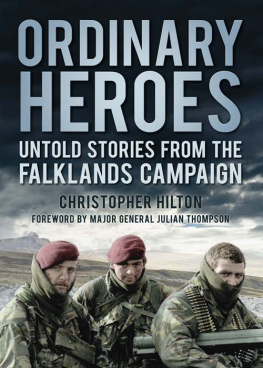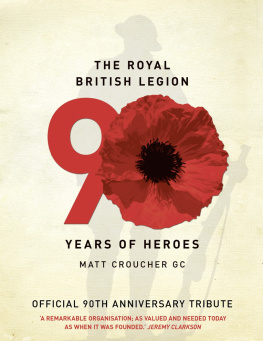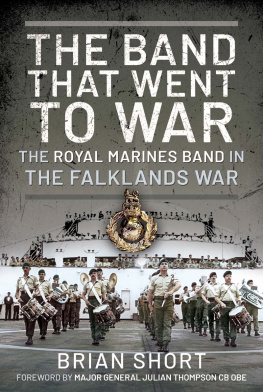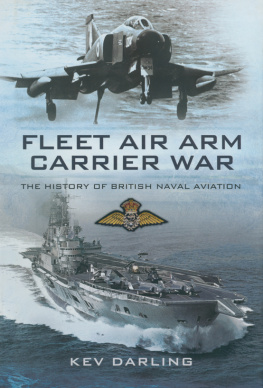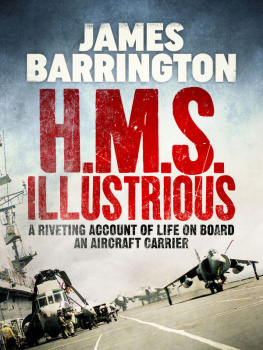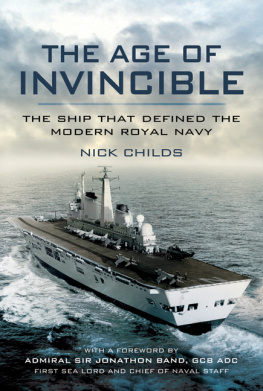A Damn Close-RunThing: A Brief History of the Falklands Conflict
RussellPhillips
SmashwordsEdition
Copyright 2011Russell Phillips
This ebook islicensed for your personal enjoyment only. This ebook may not bere-sold or given away to other people. If you would like to sharethis book with another person, please purchase an additional copyfor each recipient. If you are reading this book and did notpurchase it, or it was not purchased for your use only, then pleasereturn to Smashwords.com and purchase your own copy. Thank you for respecting the hard workof this author.
Also by RussellPhillips:
Weapons & Equipment of the U.S. Army
An Ineffective System: The M247 Sergeant York
Battle of the River Plate
Szent Istvn: Hungary's Battleship
###
Table of Contents
A Damn Close-Run Thing: ABrief History of the Falklands Conflict
"It was adamn close-run thing"
Major-General Moore, commander of the British land forces in theSouth Atlantic
Introduction
Author's note:unless specified otherwise, times are always given in the localtime zone.
The FalklandIslands are an archipelago consisting of two large islands (WestFalkland and East Falkland), and 776 smaller islands. The islandsare situated roughly 250 nautical miles east of southern Argentina,in the South Atlantic. South Georgia is a large island around 700nautical miles east-south-east of the Falkland Islands. The SouthSandwich Islands are a chain of small islands 280 nautical milessouth-east of South Georgia.
In 1982, Argentinaand the United Kingdom had both claimed sovereignty over theFalkland Islands (referred to as Islas Malvinas by theArgentinians) and their dependencies, South Georgia and the SouthSandwich Islands, for over 150 years. At the time of the FalklandsConflict, most Britons were only vaguely aware of the islands'existence, but the Argentinians felt it was an issue of greatimportance and national pride. One Argentinian army officer said,"We viewed the Malvinas as a lost treasure with a sentimentallonging that everyone in Argentina shared."
Historical Context
To properlyunderstand the 1982 Falklands Conflict between Argentina and theUnited Kingdom, it is useful to have some understanding of thehistorical context.
The disputebetween the UK and Argentina over sovereignty of the FalklandIslands dates back to 1816, when Argentina declared itsindependence from Spain, which had previously claimed sovereigntyover the islands. In 1945, Argentina brought its claim to thenewly-formed United Nations, thus raising international awarenessof the issue. The UK offered to take the matter to mediation in theInternational Court of Justice in the Hague in 1947, 1948 and 1955,but Argentina declined the offers, saying that the court did nothave jurisdiction to rule on the matter. The UK unilaterallysubmitted the case to the court in 1955, but the case was removedfrom the court's lists the following year, after Argentina statedthat they would not accept the court's decision. Also in 1955,Argentina set up a small station named Teniente Esquivel on Thule,one of the South Sandwich Islands, but this was evacuated a yearlater.
In 1964, theUnited Nations passed a resolution calling on the UK and Argentinato find a peaceful resolution to the sovereignty dispute, bearingin mind the interests of the islanders. Argentina has always arguedthat the islanders are not indigenous and were brought in toreplace the Argentinian population that was expelled after there-establishment of British rule in 1833, and therefore have noright to self-determination.
In 1966, 20 armedArgentinian revolutionaries hijacked a DC-4 aircraft and forced thepilot to land on the racecourse at Stanley (the capital of theFalkland Islands), where they took four islanders hostage. TheFalkland Islands Defence Force (FIDF) and local Royal Marinesdetachment kept the aircraft and hijackers contained. The hijackerssurrendered with no loss of life, and were returned to Argentina.In November 1968 a light aircraft from Argentina landed on ElizaCove Road outside Stanley, prompting a similar alert, but thepassengers were unarmed Argentinian journalists.
In 1976, anArgentinian gunboat fired upon a British Antarctic Survey ship. InNovember of that year a party from the Argentine Air Force landedon Thule and set up a small military base with barracks, helicopterlanding pad, radio station and flagpole, from which they flew theArgentinian flag. The new base, named Corbeta Uruguay, was notpublicly announced, but was discovered by the British a monthlater. The British government made a number of official protests,but the base remained in Argentinian hands until after theFalklands Conflict.
In 1977, theArgentinian navy cut off the fuel supply to Port Stanley Airport.The UK government, concerned that Argentina might mount an armedexpedition, dispatched a nuclear submarine (HMS Dreadnought) andtwo frigates (HMS Alacrity and Phoebe). These deployments werediscreetly leaked to the Argentinian government, but not madepublic until some years later.
Meanwhile,Argentina and the UK had held a series of talks between 1964 and1981, and some progress was made in establishing links between theislands and Argentina. Regular flights between Argentina and theislands were established, and the Argentinian national oil and gascompany started to supply the islands. However, there was noprogress on the central issue of sovereignty. The islanders,believing that the greater links to Argentina were the first stepstowards Argentinian sovereignty, set up a group to lobby the UKparliament on their behalf. Just as Argentina refused to recognisethe islanders' right to self-determination, successive UKgovernments, under intense lobbying, maintained a position that thewishes of the islanders were paramount. Since neither governmentwas willing or able to change their fundamental position, furtherprogress was not possible.
The 1980s
In 1980, NicholasRidley, the Minister of State for the newly-elected Conservativegovernment, travelled to the Falkland Islands to put a proposal tothe islanders which would see sovereignty transferred to Argentina,but with the islands leased back to the UK, and under UK control,for a fixed term (100 years was suggested), after which Argentinawould take over. He was given a cool reception, and the islandersroundly rejected the proposal.
In 1981, theBritish Nationality Act was passed, which removed BritishCitizenship from many islanders. As part of a program of defencecuts, it was announced that the ice-breaker HMS Endurance (the onlypermanent Royal Navy presence in the South Atlantic) was to bescrapped. These cuts also required the decommissioning of theaircraft carrier HMS Hermes, and the aircraft carrier HMSInvincible was due to be sold to Australia. These developmentsconvinced the ruling military junta in Argentina that the UK wouldnot oppose a military takeover of the islands, which they hopedwould divert public opinion from various problems at home, and sothey made plans for an invasion, to take place in 1982.
In December 1981,an Argentinian named Constantino Davidoff paid 160,000 for therights to dismantle and salvage scrap metal from the now-defunctwhaling stations on South Georgia. When he enquired about hiringArgentinian naval vessels for transport, he became an unwittingpart of the plan to take the Falkland Islands. On the 17th of March1982, he and 41 workers landed at Leith, without a landing permit,and without alerting the British Antarctic Survey (BAS) base atGrytviken. Two days later, they were spotted by members of the BAS,who reported that some of the men were in military uniform, and anArgentinian flag was flying from a building. Governor Hunt, basedat Stanley in the Falklands, sent a message to the Argentinians,informing them that they had landed illegally, and ordering them toboard their ship and report to the base commander at Grytviken forfurther instructions. Meanwhile, HMS Endurance was ordered to SouthGeorgia, with a detachment of Royal Marines on board.

